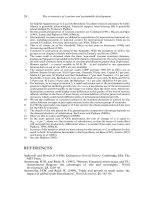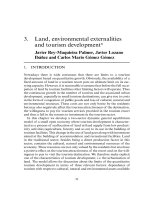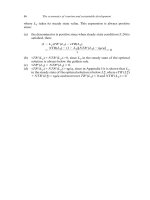THE ECONOMICS OF MONEY,BANKING, AND FINANCIAL MARKETS 156
Bạn đang xem bản rút gọn của tài liệu. Xem và tải ngay bản đầy đủ của tài liệu tại đây (29.52 KB, 1 trang )
124
PA R T I I
Financial Markets
We can conduct the same steps for bonds with a longer maturity so that we
can examine the whole term structure of interest rates. Doing so, we will find that
the interest rate of int on an n-period bond must equal
int *
i t + i te + 1 + i te + 2 + . . . + i et + (n - 1)
n
(2)
Equation 2 states that the n-period interest rate equals the average of the oneperiod interest rates expected to occur over the n-period life of the bond. This is
a restatement of the expectations theory in more precise terms.1
APP LI CAT IO N
Expectations Theory and the Yield Curve
The one-year interest rate over the next five years is expected to be 5%, 6%, 7%,
8%, and 9%. Given this information, what are the interest rates on a two-year bond
and a five-year bond? Explain what is happening to the yield curve.
Solution
The interest rate on the two-year bond would be 5.5%.
i t + i et + 1 + i et + 2 + . . . + i te + (n - 1)
int *
n
where
it * year 1 interest rate * 5%
i te+ 1 * year 2 interest rate * 6%
n * number of years
*2
Thus
i 2t *
5% + 6%
* 5.5%
2
The interest rate on the five-year bond would be 7%.
it + ite+ 1 + ite+ 2 + . . . + ite+ (n - 1)
int *
n
where
it * year 1 interest rate * 5%
i te+ 1 * year 2 interest rate * 6%
i et + 2 * year 3 interest rate * 7%
i et + 3 * year 4 interest rate * 8%
i et + 4 * year 5 interest rate * 9%
n * number of years * 5
1
The analysis here has been conducted for discount bonds. Formulas for interest rates on coupon
bonds would differ slightly from those used here but would convey the same principle.









